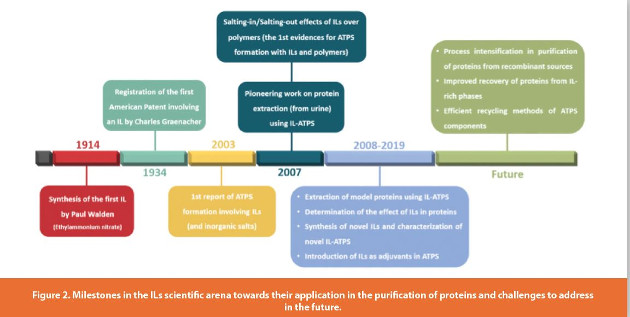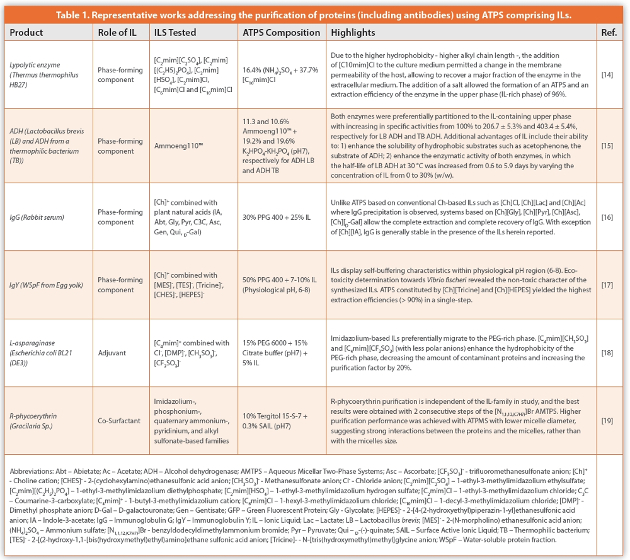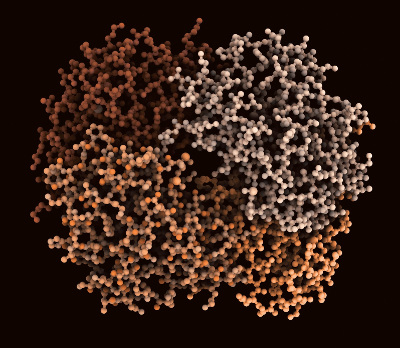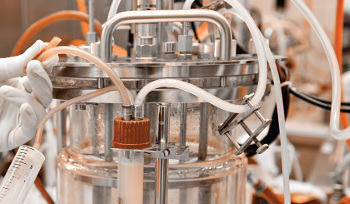The advent of biopharmaceuticals in modern medicine has brought enormous benefits to treat chronic and life-threatening diseases while improving the well-being of humans. Proteins (including antibodies) represent a large fraction of the biopharmaceuticals market, but are still amongst the costliest options due to the lack of cost-effective purification techniques. The most relevant strategies in the downstream processing of protein-based biopharmaceuticals are the highly selective nature of chromatographic techniques, which however, present some drawbacks including the difficulty to apply in large scale due to batch processing, large scale pressure drops,1 low chemical and proteolytic stability, and high cost.2 To overcome such limitations, alternative downstream processes have been proposed, such as aqueous two-phase systems (ATPS). These systems were initially proposed by Albertsson in the mid-1950s as an alternative to traditional liquid-liquid extraction techniques,3 consisting of two immiscible aqueous-rich phases that separate above given concentrations, being one aqueous phase enriched in one of the solutes while in the other phase the second component prevails.4 An overview of the application of ATPS for the purification of proteins is represented in Figure 1, being additionally illustrated a typical ATPS ternary phase diagram in an orthogonal representation, in which the water concentration is not shown (pure water becomes the origin of the orthogonal axes, corresponding to the amount required to reach 100 wt% in a given mixture composition).4
In comparison with other extraction techniques, ATPS display several advantages, spanning from their environmentally friendly and biocompatible character, low cost, continuous operation and easiness in scaling-up. Moreover, being mainly composed of water, ATPS provide a gentle environment for the separation or downstream processing of proteins.1,5 Based on the exposed, ATPS have become a widely studied technology for their ability to separate and purify a wide range of biomolecules, including nucleic acids, proteins, antibodies and cells.

Polymers and salts were initially investigated as the main phaseforming components of ATPS. More recently, following the pioneering work by Rogers and co-workers in 2003 on the possible creation of ATPS by the addition of aqueous solutions of ionic liquids (ILs) to inorganic salts,6 the extractive performance of ATPS comprising ILs has been deeply investigated. ILs are liquid molten salts typically composed of large and unsymmetrical organic cations and organic or inorganic anions, which generally present high thermal and chemical stabilities, and are non-flammable and non-volatile at ambient conditions. Furthermore, their aqueous solutions display an improved and unique solvation performance, thereby allowing enhanced extractions. An additional remarkable feature of ILs is their tunable character, which due to the large number of ion combinations allows researchers to adjust their physico-chemical properties to meet the requirements of specific applications.5 Indeed, in IL-ATPS there is the ability to tailor the phases’ polarities by a proper manipulation of the IL cation/anion design, allowing to overcome the limited polarity range of polymer-based ATPS.4 On their way as agents for the purification of proteins, ILs have travelled a long path with major achievements in the 21th century (Figure 2). Despite not being recent compounds – the synthesis of the first IL was reported more than a century ago by Paul Walden -, the first work involving the formation of IL-ATPS was reported in 2003, which were later (2007) applied for the first time to extract proteins from urine by Wang and co-workers.7 Also in 2007, the first evidence pointing out to the possible creation of ATPS involving ILs and polymers were documented by Rebelo and co-workers.8 Research on IL-ATPS has been driven in the last decade towards the use of ILs as feasible alternatives to polymer- and salt-rich phases in ATPS,4 namely in terms of: 1) characterizing the effect of ILs in biomolecules;9,10 2) synthesis of ILs of a more biodegradable and biocompatible nature;11 and 3) improving the recyclability of ILs.12
Proteins Stability in the IL Milieu
The application of ILs as solvent stabilizing media for proteins has been a hot topic of research. Up to date, most studies in the literature point out the importance of understanding the IL-protein interactions for any protein-related application. Moreover, it became clear the difficulty in devising general rules for protein stability in ILs due to the odd effects that distinct proteins suffer in the presence of ILs in which both the cation and anion properties as well as the lypophilic-hydrophylic nature of the IL are changed.5 Albeit different perspectives have been reported, exceptionally high catalytic activities in the presence of ILs were obtained, as exemplified by the cytochrome c which displays an increased catalytic activity of more than 50-fold (in comparison with standard phosphate buffer solutions) when in the presence of aqueous solutions of cholinium glutarate (IL:H2O, 1:1).13 An overview of the impact of ILs in the stability of a wide range of proteins, including laccase, lysozyme, cytochrome c, alcohol dehydrogenases (among many others) were recently reported by Kumar et al (2017)9 and Schindl et al (2019).10 Overall, high stability and enzyme activity can be achieved by the proper selection of the IL chemical structure and its concentration.

Subscribe to our e-Newsletters
Stay up to date with the latest news, articles, and events. Plus, get special offers
from American Pharmaceutical Review – all delivered right to your inbox! Sign up now!
Purification of Proteins Using ATPS Comprising ILs
Representative works of ATPS comprising ILs for the extraction of proteins are shown in Table 1, namely with ILs as ATPS phase-forming components with salts14,15 or polymers,16,17 as adjuvants18 in polymersalt systems or as co-surfactants19 in aqueous micellar two-phase systems (AMTPS).

Gutiérrez-Arnillas et al14 proposed an integrated strategy for the recovery of a lipolytic enzyme, belonging to the class of lipases (EC 3.1.1.2) which have attracted much interest and with widespread use in several industry sectors including food, drugs, fuels and detergents. The overall process includes the solubilization of Thermus thermophilus HB27 biomass by imidazolium-based ILs and the addition of an inorganic salt, aiming the formation of an ATPS and further extraction. Among the ILs tested, the IL containing the longer alkyl side chain length – [C10mim]Cl, 1-decyl-3-methylimidazolium chloride – entailed a greater solubilization of cell biomass since it interacts with the negatively charged head of the Thermus membrane displacing cations, while the alkyl chain inserts into the membrane and forms channels. As a result, the majority of the enzyme activity was found in the extracellular fraction. Then, the IL was salted-out by the addition of an inorganic salt [(NH4)2SO4], being the majority (96%) of the target enzyme recovered in the top phase, i.e. the IL-rich phase.14
Dreyer and Kragl15 evaluated the possibility of combining an extraction process based on ATPS with the advantageous properties displayed by ILs, namely their ability to improve the catalytic activity of two alcohol dehydrogenases. To this end, ILs composed by acyclic ammonium salts containing cations with oligoethyleneglycol units - Ammoeng110™ and potassium phosphate salt (K2HPO4/KH2PO4 at a ratio of 1.82:1.00, pH7) were used for the formation of ATPS at 4 °C, envisaging the purification of two alcohol dehydrogenases (ADH) from Lactobacillus brevis (ADH LB) and a thermophilic bacterium (ADH TB), which were independently expressed in E. coli. By proper tailoring the concentrations of IL and inorganic salt resorting experimental design and using the specific activity (U μg-1 protein) as the target parameter, both enzymes were succesfully extracted towards the IL-containing upper phase with 11.3% (w/w) IL and 19.2 % (w/w) salt for ADH LB and 10.6% (w/w) IL and 19.6% (w/w) salt for ADH TB. In general, an increase of the specific activity of both enzymes was obtained in the IL-rich phase, indicating that they are recovered in a more purified form. Additional advantages of using Ammoeng110™ include the enhanced stability displayed by the target enzymes, as shown by the increase of the half-life of ADH LB at 30 °C from 0.6 to 5.9 days in the presence of different concentrations of IL ranging from 0 to 30 % (w/w), and also a favorable increase in the solubility of hydrophobic substrates such as acetophenone, namely from 0.038 to 1.75 M in the presence of 70% (w/w) of IL.15

Based on the need of developing more benign, scalable and cost-effective techniques for the purification of immunoglobulin G (IgG) as a major biopharmaceutical, Mondal et al16 reported the synthesis of bio-based ILs formed by the cholinium cation and anions derived from natural sources and their application for the creation of ATPS with polypropylene glycol with a molecular weight of 400 g.mol-1 (PPG 400). Among the synthesized ILs – Choline indole-3-acetate ([Ch][IA]), choline abietate ([Ch][Abt]), choline glycolate ([Ch][Gly]), choline pyruvate ([Ch][Pyr]), choline coumarine-3-carboxylate ([Ch] [C3C]), choline-L-ascorbate ([Ch][Asc]), choline gentisate ([Ch][Gen]), choline-D-(-)-quinate ([Ch][Qui]) and choline-D-galactouronate ([Ch] [D-Gal]) -, ILs with higher octanol-water partition coefficients - [Ch] [Abt], [Ch][C3C] and [Ch][Gen] were not able to form an ATPS with PPG 400, although an exception to this pattern was [Ch][IA]. Contrarily to other conventional cholinium-based ATPS, namely cholinium acetate, cholinium lactate and cholinium chloride, where precipitation of pure IgG is observed, ATPS based on [Ch][Gly], [Ch][Pyr], [Ch][Asc], [Ch] [D-Gal] and [Ch][Qui] allow the complete extraction and recovery of IgG in a single-step. From the bio-IL-based ATPS herein evaluated, the system composed by [Ch][Asc] appears as the most promising for the extraction of IgG from real samples, which is further confirmed by the enrichment of 58% on the IgG purity when compared with IgG present in rabbit serum.16
Aiming the extraction of immunoglobulin Y (IgY) from egg yolk envisaging their application in passive immunization as an alternative to IgG produced by small mammals and considering that the stability of this biopharmaceutical (among many other proteins) is greatly influenced by pH, Freire and co-workers17 synthesized a series of ILs with self-buffering characteristics within the physiological pH region (6-8) constituted by the cholinium cation and anions derived from Good’s buffers (GB-ILs). GB-ILs and PPG 400 were applied in ATPS formation and investigated as extraction platforms for IgY from the water-soluble proteins fraction of egg yolk. In general, the highest extraction efficiencies (above 90% in a single-step) were found for ATPS composed of ILs containing anions derived from Tricine and HEPES, although the major contaminant β-livetin was not entirely removed. Nevertheless, these systems proved to be useful owing to their benign character and ability to maintain the integrity of proteins.17
Along with their use as phase-forming components of ATPS, ILs have also been applied as adjuvants18 or co-surfactants.19 Santos et al18 investigated the use of imidazolium-based ILs in polymer-salt systems as a way to increase the purification factors of a clinically relevant enzyme - L-asparaginase. The authors found that ILs preferentially migrate to the polyethylene glycol (PEG) rich-phase while increasing the hydrophobicity of this phase, resulting in a decrease of contaminant proteins and higher purification factors. Overall, an integrated strategy for the purification of periplasmatic L-asparaginase was developed, involving: cell permeabilization, a pre-purification step with ammonium sulfate precipitation, IL-ATPS as the main purification step, and the recovery of the target protein and contaminant proteins by ultrafiltration from the respective phases, thereby allowing the reusing and recycling of both phases in new cycles of purification.18
Vicente et al19 used surface-active ionic liquids (SAILs) as cosurfactants for the isolation of R-phycoerythrin from Red macroalgae, bioactive fluorescent compounds with a widespread use in food, pharmaceutical, biomedical and cosmetic fields. This was accomplished using AMTPS based on tergitol 15-S-7 with SAILs as co-surfactants. Among the different families of SAILs tested, the AMTPS based in benzyldodecyldimethylammonium bromide - [N1,1,12,(C7H7)]Br, allowed the recovery of R-phycoerythrin without being contaminated by R-phycocyanin, where behavior may be due to the different sizes of both phycobiliproteins or by specific interactions taking place between the micelles formed and the contaminant fluorescent protein. Envisaging an increase in the purity of the target protein, the authors proposed the use of a two-step process using sequential AMTPS, and described a theoretical approach for the polishing of R-phycoerythrin and the recycling and reuse of the phase-forming components.19
On the Hunt for More Biocompatible ILs
Some well-known toxicological risks displayed by some ILs, both to environment and humans, and that may hinder further large-scale applications of ILs has driven the scientific community towards the development of novel synthetic strategies, thus resulting in “greener” and more biocompatible compounds.20 These ILs use both anionic and cationic counterparts derived from biocompatible and natural sources, such as the cholinium and glycine-betaine analogs as cations which are combined with amino acids, natural acids, among others.5,20 Based on the rationale that cholinium chloride is a water soluble essential nutrient important for cell membrane structure and for the synthesis of vitamins,17 the use of cholinium as the cationic moiety has emerged as the most effective approach towards the development of ILs of a more biocompatible nature.20 This cation has been paired with anions derived from plants natural acids,11 amino acids,21 or Good’s buffers,17 and successfully applied in the formation of ATPS together with salts or polymers foreseeing the extraction of proteins. In general, most of these ILs derived from natural sources present a non-ecotoxic character towards the bioluminescent bacteria Vibrio fi scheri,17 and also revealed to be non-cytotoxic to human cell lines.22 More recently, ILs based on glycine-betaine, which acumulate in a wide variety of plant species in response to environmental stress, have also been investigated.20,23 It was found that an increase in the alkyl side chain length of ILs analogues of glycine-betaine increases their ecotoxic nature, although these ILs display a lower ecotoxicity to Vibrio fi scheri than those commercially available and usually applied for ATPS formation.23

Protein Recovery and Recycling and Reusing of ILs
Aiming for a decrease in the environmental and economic impact of ATPS, while foreseeing the industrial implementation of IL-based ATPS processes, the recycling and reusing of ATPS components (including ILs) are essential steps to implement.5,19 In general, several methods have been investigated to recover hydrophilic ILs, such as back-extraction (solvent extraction, supercritical CO2), solid-phase extraction, induced phase separation (salting-out, temperature), membrane-based processes or magnetic separations.24 However, the general impact of these processes in the stability of the target proteins is not entirely known since there are few studies addressing the recycling of ILs in protein purification ILbased ATPS processes. As shown in Figure 3, we highlight three strategies comprising the successful recovery of proteins and recycling of ILs. Pereira et al showed that bovine serum albumin (BSA) can be successfully recovered from aqueous solutions of phosphoniumbased ILs by dialysis, and the IL reused at least two more times without decreasing their high extraction effi ciencies for BSA (ca. 100%).12 In addition to dialysis, Ramalho et al demonstrated that IgG could be recovered from IL-rich phases (cholinium dihydrogen phosphate and cholinium lactate) using ultrafi ltration based on the application of a cut-off fi lter of 30 kDa.25
Based on the use of ATPS composed by cholinium-based ILs and PPG 400, a thermosensitive, non-toxic and biodegradable polymer, Li et al26 showed that by increasing the temperature, the polymer can be recovered and reused in the next extraction process. A distinct approach for the recovery of GFP from the bottom phase of an ATPS composed of 42% (w/w) of PPG 1000 and 4.4 % (w/w) of N,N-dimethylammonium N’,N’-dimethylcarbamate (DIMCARB), Song et al27 subjected the IL-rich phase to rotary evaporation (45 °C and 85 mbar for 1 h). It should be however remarked that this approach is possible because a protic IL was used. During the process, DIMCARB dissociated into the gaseous dimethylamine and CO2 but as the gasses passed through a condenser unit, the re-association occurs and the DIMCARB is reformed in the liquid state. Moreover, FTIR and 13C NMR analysis confirmed the successful recovery of DIMCARB from the bottom-phase while the stability of GFP was well preserved during distillation.27
Outlook

Boosted by intrinsic favorable characteristics displayed by ATPS (biocompatibility, short equilibration times and easiness in scaleup), coupled to the advantageous properties generally displayed by ILs (non-flammability, tunable character and good solvent media for biomolecules), ATPS comprising ILs have emerged as a powerful technique for the purification of proteins. In general, their use as phase-forming components allows high extraction efficiencies by favoring the partition of proteins to the IL-rich phase. On the other hand, the use of ILs as adjuvants in low concentrations in typical polymer-polymer or polymer-salt ATPS highly enhances the selectivity of such systems, thus allowing the recovery of highly purified protein fractions. As pointed out earlier by McQueen and Lai,28 the benefits of ATPS are being increasingly recognized by pharmaceutical companies, and despite ATPS use identical instrumentation and similar methodologies to the already implemented methods, the cost of typical components (mainly polymers) in large-scale ATPS is still a challenge for their widespread use in industry.28 However, some ILs are already produced at the industrial level with relatively low production costs, and as the research intensification on the development of more environmentally and human-friendly ILs proceeds it can be expected that in the near future ILs derived from natural and renewable sources could be obtained at a low cost.
Overall, due to the demand for low-cost and more sustainable protein purification technologies, ATPS comprising ILs should be considered as a viable and effective alternative feasible of industrial application.
This work was developed within the scope of the project CICECOAveiro Institute of Materials, FCT Ref. UID/CTM/50011/2019, financed by national funds through the FCT/MCTES and was financiallysupported by the project “IL2BioPro” - PTDC/BII-BBF/030840/2017- funded by FEDER, through COMPETE2020 - Programa Operacional Competitividade e Internacionalização (POCI), and by national funds (OE), through FCT/MCTES.
References:
- Iqbal M, Tao Y, Xie S, Zhu Y, Chen D, Wang X, Huang L, Peng D, Sattar A, Shabbir MAB, Hussain HI, Ahmed S, Yuan Z. Aqueous two-phase system (ATPS): an overview and advances in its applications. Biol Proced Online. 2016;18(18).
- Rosa PA, Azevedo AM, Sommerfeld S, Backer W, Aires-Barros MR. Aqueous two-phase extraction as a platform in the biomanufacturing industry: economical and environmental sustainability. Biotechnol Adv. 2011;29(6):559-567.
- Albertsson PA. Partitioning of Cell Particles and Macromolecules. 3rd ed. New York, Wiley; 1986.
- Freire MG, Cláudio AF, Araújo JM, Coutinho JA, Marrucho IM, Canongia Lopes JN, Rebelo LP. Aqueous biphasic systems: a boost brought about by using ionic liquids. Chem Soc Rev. 2012;41(14):4966-4995.
- Ventura SPM, Silva FA, Quental MV, Mondal D, Freire MG, Coutinho JAP. Ionic-Liquid-Mediated extraction and separation processes for bioactive compounds: Past, Present, and Future Trends. Chem Rev. 2017;117:106984-107052.
- Gutowski KE, Broker GA, Willauer HD, Huddleston JG, Swatloski RP, Holbrey JD, Rogers RD. Controlling the aqueous miscibility of ionic liquids: aqueous biphasic systems of watermiscible ionic liquids and water-structuring salts for recycle, metathesis, and separations. J Am Chem Soc. 2003;125(22):6632-6633.
- Du Z, Yu YL, Wang JH. Extraction of proteins from biological fluids by use of an Ionic Liquid/Aqueous Two-phase System. Chem Eur J. 2007;13:2130-2137.
- Visak ZP, Canongia Lopes JN, Rebelo LPN. Ionic liquids in polyethylene glycol aqueous solutions: salting-in and salting-out effects. Monatsh Chem. 2007;138:1153-1157.
- Kumar A, Bisht M, Venkatesu P. Biocompatibility of ionic liquids towards protein stability: A comprehensive overview on the current understanding and their implications. Int J Biol Macromol. 2017;96:611-651.
- Schindl A, Hagen ML, Muzammal S, Gunasekera HAD, Croft AK. Proteins in ionic liquids: Reactions, applications, and futures. Front Chem. 2019;7:347.
- Mondal D, Sharma M, Quental MV, Tavares APM, Prasad K, Freire MG. Suitability of biobased ionic liquids for the extraction and purification of IgG antibodies. Green Chem. 2016;18:6071-6081.
- Pereira MM, Pedro SN, Quental MV, Lima ÁS, Coutinho JA, Freire MG. Enhanced extraction of bovine serum albumin with aqueous biphasic systems of phosphonium- and ammonium-based ionic liquids. J Biotechnol. 2015;206:17-25.
- Bisht M, Mondal D, Pereira MM, Freire MG, Venkatesu P, Coutinho JAP. Long-term protein packaging in cholinium-based ionic liquids: improved catalytic activity and enhanced stability of cytochrome c against multiple stresses. Green Chem. 2017;19:4900-4911.
- Gutiérrez-Arnillas E, Deive FJ, Sanromán MA, Rodríguez A. Ionic liquids for the concomitant use in extremophiles lysis and extremozymes extraction. Bioresour Technol. 2015;186:303-308.
- Dreyer S, Kragl U. Ionic liquids for aqueous two-phase extraction and stabilization of enzymes. Biotechnol Bioeng. 2008;99(6):1416-1424.
- Mondal D, Sharma M, Quental MV, Tavares APM, Prasad K, Freire MG. Suitability of biobased ionic liquids for the extraction and purification of IgG antibodies. Green Chem. 2016;18:6071-6081.
- Taha M, Almeida MR, Silva FA, Domingues P, Ventura SP, Coutinho JA, Freire MG. Novel biocompatible and self-buffering ionic liquids for biopharmaceutical applications. Chemistry. 2015;21(12):4781-4788.
- Santos JHPM, Flores-Santos JC, Meneguetti GP, Rangel-Yagui CO, Coutinho JAP, Vitolo M, Ventura SPM, Pessoa Jr A. In situ purification of periplasmatic L-asparaginase by aqueous two-phase systems with ionic liquids (ILs) as adjuvants. J Chem Technol Biotechnol. 2018;93:1871-1880.
- Vicente FA, Cardoso IS, Martins M, Gonçalves CVM, Dias ACRV, Domingues P, Coutinho JAP, Ventura SPM. R-Phycoerythrin extraction and purification from fresh Gracilaria sp. Using thermo-responsive systems. Green Chem. 2019;21:3816-3826.
- Gomes JM, Silva SS, Reis RL. Biocompatible ionic liquids: fundamental behaviours and applications. Chem Soc Rev. 2019;Advance Article.
- Song CP, Ramanan RN, Vijayaraghavan R, MacFarlane DR, Chan E-S, Ooi C-W. Green, aqueous two-phase systems based on cholinium aminoate ionic liquids with tunable hydrophobicity and charge density. ACS Sustainable Chem Eng. 2015;3(12):3291-3298.
- Pedro AQ, Pereira P, Quental MJ, Carvalho AP, Santos SM, Queiroz JA, Sousa F, Freire MG. Cholinium-based Good’s buffers ionic liquids as remarkable stabilizers and recyclable preservation media for recombinant small RNAs. CS Sustainable Chem Eng. 2018;612:16645-16656.
- Pereira MM, Almeida MR, Gomes J, Rufino AFCS, Rosa ME, Coutinho JAP, Mohamadou A, Freire MG. Glycine-betaine ionic liquid analogues as novel phase-forming components of aqueous biphasic systems. Biotechnol Prog. 2018,34(5):1205-1212.
- Mai NL, Ahn K, Koo Y-M. Methods for recovery of ionic liquids – A review. Process Biochem. 2014;49(5):872-881.
- Ramalho CC, Neves CMSS, Quental MV, Coutinho JAP, Freire MG. Separation of immunoglobulin G using aqueous biphasic systems composed of cholinium-based ionic liquids and poly(propylene glycol). J Chem Technol Biotechnol. 2018;93(7):1931-1939.
- Li Z, Liu X, Pei Y, Wang J, He M. Design of environmentally friendly ionic liquid aqueous two-phase systems for the efficient and high activity extraction of proteins. Green Chem. 2012;14(10):2941-2950.
- Song CP, Liew PE, Teh Z, Lim SP, Show PL, Ooi CW. Purification of the recombinant green fluorescent protein using aqueous two-phase system composed of recyclable CO2-based alkyl carbamate ionic liquid. Front Chem. 2018;6:529.
- McQueen L, Lai D. Ionic liquid aqueous two-phase systems from a pharmaceutical perspective. Front Chem. 2019;7(135).
Author Biographies
Leonor S. Castro completed her MSc degree in Molecular Biotechnology in 2016 by University of Aveiro - UA, Portugal, where she focused on the separation of biomolecules using aqueous two-phase systems. Currently, she is a research fellow working on the application of aqueous-two phase systems for the purification of protein-based biopharmaceuticals.
Patrícia Pereira completed her PhD in Biochemistry in 2016 by Centro de Investigação em Ciências da Saúde, University of Beira Interior - CICSUBI, Portugal, and is currently a Post-doctoral researcher at Instituto de Tecnologia Química e Biológica António Xavier, University Nova de Lisboa (ITQB-NOVA, Portugal). Her current research interests include the study of the structure, mechanism of action and function of ribonucleases in pathogen bacteria.
Mara G. Freire completed her PhD in Chemical Engineering in 2007 by UA, followed by post-doctoral activities at ITQB-NOVA, Portugal. Since 2014, Freire is a Coordinator Researcher at CICECO - Aveiro Institute of Materials, Chemistry Department, UA, Portugal. She is the coordinator of Group 5 - Biomedic and Biomimetic Materials - within CICECO, and member of the Young Scientists Seminar of the Lisbon Academy of Sciences. In addition to other projects and awards, in 2014 Freire was awarded with a European Research Council (ERC) Grant. Her research interests comprise the development of sustainable separation platforms for value-added compounds using aqueous solutions of ionic liquids and other organic salts, polymers, and deep eutectic solvents.
Augusto Q. Pedro completed his PhD in Biochemistry in 2016 by CICSUBI, Portugal, and was a Post-doctoral researcher at CICECO – Aveiro Institute of Materials, Chemistry Department, UA, Portugal, hired as a team member under an ERC-funded project. Currently, he is a 1st level Doctorate Researcher at CICECO, UA, Portugal, working on the development of alternative downstream processing technologies for biopharmaceuticals.